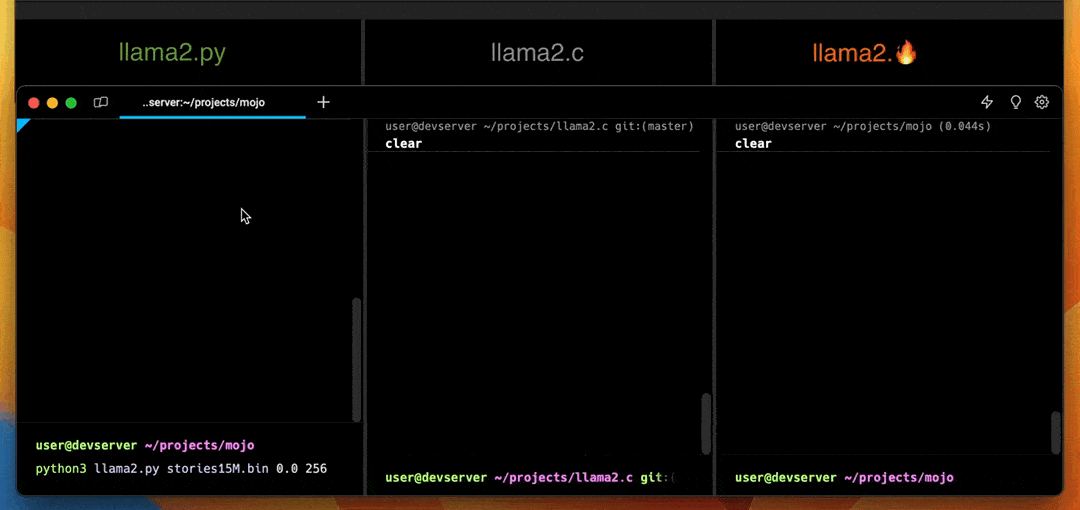Have you ever wanted to inference a baby Llama 2 model in pure Mojo? No? Well, now you can!
supported version: Mojo 0.4.0
With the release of Mojo, I was inspired to take my Python port
of llama2.py and transition it to Mojo. The result? A version that leverages
Mojo's SIMD & vectorization primitives, boosting the Python performance by nearly 250x. Impressively, the Mojo version
now outperforms the original llama2.c compiled in runfast mode out of the box by 15-20%.
This showcases the potential of hardware-level optimizations through Mojo's advanced features.
I think this also can help us to see how far can we go with the original llama2.c hardware optimizations.
Since there were some debates was this comparison legit or not I did some research and found that in runfast
mode llama2.c
includes multiple optimizations like aggressive vectorization, which makes comparison fair with Mojo SIMD vectorization.
UPD. further improvements of llama2.mojo parallelization make it working slightly better or the same as C on different models.
At the moment, the following models were successfully executed via llama2.mojo:
| Model |
|---|
| stories 260K, 15M, 110M |
| Tinyllama-1.1B-Chat-v0.2 |
mojo vs 6 programming languages
| Model | llama2.c (OMP/parallelized) | llama2.mojo (parallelized) | llama2.mojo (naive matmul) | llama2.py |
|---|---|---|---|---|
| stories15M.bin | 435 tok/s | 440 tok/s | 67.26 tok/s | 1.3 tok/s |
| stories110M.bin | 64 tok/s | 63 tok/s | 9.20 tok/s | - |
| TinyLlama-1.1B | 7.25 tok/s | 7.25 tok/s | - | - |
OS: Ubuntu 20.04
CPU(s): 6
Model name: Intel(R) Core(TM) i7-8700 CPU @ 3.20GHz
CPU MHz: 3191.998
Make sure you have installed and configured mojo on your environment
Or you can use mojo playground to run this model.
HuggingFace - https://huggingface.co/spaces/radames/Gradio-llama2.mojo
First, navigate to the folder when you keep your projects and clone this repository to this folder:
git clone https://github.com/tairov/llama2.mojo.gitThen, open the repository folder:
cd llama2.mojoNow, let's download the model
wget https://huggingface.co/karpathy/tinyllamas/resolve/main/stories15M.binThen, just run the Mojo
mojo llama2.mojo stories15M.bin -s 100 -n 256 -t 0.5 -i "Mojo is a language"example output
num hardware threads: 6
SIMD vector width: 16
checkpoint size: 60816028 [ 57 MB ]
n layers: 6
vocab size: 32000
Mojo is a language that people like to talk. Hephones are very different from other people. He has a big book with many pictures and words. He likes to look at the pictures and learn new things.
One day, Mojo was playing with his friends in the park. They were running and laughing and having fun. Mojo told them about his book and his friends. They listened and looked at the pictures. Then, they saw a picture of a big, scary monster. They were very scared and ran away.
Mojo was sad that his book was gone. He told his friends about the monster and they all felt very sad. Mojo's friends tried to make him feel better, but nothing worked. Mojo never learned his language again.
achieved tok/s: 440.21739130434781
docker build --build-arg AUTH_KEY=<your-modular-auth-key> -t llama2.mojo .
docker run -it llama2.mojoWith Gradio UI:
# uncomment the last line in Dockerfile CMD ["python", "gradio_app.py"]
docker run -it -p 0.0.0.0:7860:7860 llama2.mojoIf you use or discuss llama2.mojo in your academic research, please cite the project to help spread awareness:
@misc{llama2.mojo,
author = {Aydyn Tairov},
title = {Inference Llama2 in one file of pure Mojo},
year = {2023},
month = {09},
howpublished = {\url{https://github.com/tairov/llama2.mojo}},
note = {Llama2 Mojo, MIT License}
}
We kindly request that you include a link to the GitHub repository in published papers. This will allow interested readers to easily find the latest updates and extensions to the project.
llama2.mojo aims to encourage academic research on efficient implementations of transformer architectures, the llama
model, and applications of the mojo programming language. Citing the project helps growth of the knowledge community
around these topics. We appreciate your support through referencing llama2.mojo!
The TinyLlama is a 1.1B Llama model trained on 3 trillion tokens. This compactness allows it to cater to a multitude of applications demanding a restricted computation and memory footprint. This is also the reason why we select it as the first model to support.
First, navigate to the folder when you keep your projects and clone this repository to this folder:
git clone https://github.com/tairov/llama2.mojo.gitThen, open the repository folder:
cd llama2.mojoNow, let's download the model and the tokenizer
wget https://huggingface.co/kirp/TinyLlama-1.1B-Chat-v0.2-bin/resolve/main/tok_tl-chat.bin
wget https://huggingface.co/kirp/TinyLlama-1.1B-Chat-v0.2-bin/resolve/main/tl-chat.binThen, just run the Mojo
mojo llama2.mojo tl-chat.bin \
-z tok_tl-chat.bin \
-n 256 -t 0 -s 100 -i "<|im_start|>user\nGive me a python function to generate Fibonacci sequence<|im_end|>\n<|im_start|>assistant\n"example output
num hardware threads: 6
SIMD vector width: 16
checkpoint size: 4400767004 [ 4196 MB ]
n layers: 22
vocab size: 32003
<|im_start|>user
Give me a python function to generate Fibonacci sequence<|im_end|>
<|im_start|>assistant
Sure, here's a Python function that generates the Fibonacci sequence:
def fibonacci(n):
if n <= 0:
return 0
elif n == 1:
return 1
else:
return fibonacci(n-1) + fibonacci(n-2)
This function takes an integer n as a parameter and returns the next Fibonacci number. It uses a recursive approach to calculate the Fibonacci numbers, starting from 0 and working up. The function returns the value it found at the current level of the recursion, which can be either 0 or a Fibonacci number.
MIT
